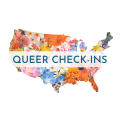The Relationship Between Race and Wellness Has Never Been More Pressing
A new Smithsonian initiative that will examine the history and legacy of race and racism kicks August 26 with a virtual summit examining these urgent issues.

This summer, Simone Biles—widely considered the greatest female gymnast of all time—shocked the sporting world when she withdrew from the majority of her events at the Tokyo 2020 Olympics. Citing her struggles with the “twisties,” a mental block that makes performing gravity-defying gymnastics moves incredibly dangerous, the 24-year-old athlete garnered widespread praise for placing her health first.
Biles later said that she drew inspiration from Naomi Osaka, the 23-year-old tennis star who withdrew from the French Open and Wimbledon in order to prioritize her mental health. The two women, both Black athletes at the top of their sports, are part of a growing wave of Black individuals “publicly [taking] their mental health into their hands in a way never seen before in elite sports,” as NBC News reported.
Lonnie Bunch, secretary of the Smithsonian Institution, says the example set by Biles, Osaka and others has lent visibility to the issue of “mental health through the lens of race.” This topic, as well as the broader relationship between race and wellness, feels particularly timely in 2021, as the United States continues to reckon with systemic racism and a pandemic that disproportionately impacts people of color.
“Part of the struggle for fairness in America is the struggle for fair health care and access to mental health care,” says Bunch.
Race, wellness and wealth will feature prominently in an upcoming forum hosted by the Smithsonian’s Our Shared Future: Reckoning With Our Racial Past initiative. Set for Thursday, August 26, at 7 p.m. ET, the virtually streamed summit will place Smithsonian scholars in conversation with authors, experts and activists. Planned programming includes sessions on the history and impact of race, the connection between health and wealth, the role of race in mental health and trauma, and local organizations that are working to reimagine a better future.
The Smithsonian announced its Reckoning With Our Racial Past initiative last summer, in the aftermath of George Floyd’s murder and the outbreak of widespread protests against police brutality. Funded through a $25 million gift from Bank of America, the campaign’s goal is “to confront race and highlight racism and social justice from a historical perspective,” says Ariana Curtis, director of content for the initiative. Reckoning With Our Racial Past also seeks to underscore its subject’s relevance today and offer insights on how to move forward as a nation.

In addition to virtual and live events, the multi-year initiative will encompass town halls, digital resources, educational tools, immersive pop-up experiences, storytelling projects, collecting efforts and more. This week’s event will be the first of three national forums.
“When I became secretary [in 2019], what was important to me was to recognize that the Smithsonian had a contemporary resonance, that it had an opportunity, really a responsibility, to be of value, to basically say: We’re going to help the public by giving it tools to grapple with daily life, from the challenge of climate change to issues of race,” says Bunch.
He adds, “When a nation is in crisis, its institutions need to step up. And clearly this country has been in crisis.”
The Smithsonian’s collections and scholars represent a wealth of expertise, and its status as a beloved, 175-year-old American institution means it’s well-positioned to bring people of different backgrounds and experiences together.
“Our network includes other museums and cultural centers all around the United States, of various sizes and missions, as well as community-based organizations, scholars and activists,” says Curtis. “We’re certainly not positing that the Smithsonian is the first organization to think about these [questions of race,] but thinking about the power that we have as a trusted institution to bring these [issues] to a larger, wider audience is really important.”
The secretary envisioned the project as a way for the Smithsonian to “do what we do best”: namely, make complicated subjects accessible to the public, provide historical and cultural context that illuminates the present, and forge connections between people who might not otherwise interact. Through the funded initiative, the Smithsonian could shine “a little light” on a moment “fraught with misinformation, hate and partisanship.”
The team tasked with developing the initiative centered its efforts on six thematic pillars: race and wellness; race and wealth; race and place; race, policy and ethics; race beyond the U.S.; and race, arts and aesthetics. All of these topics relate to work currently being conducted across the Institution, from the Smithsonian Asian Pacific American Center’s “Care Package”—an online exhibition of creative offerings released at the height of the pandemic, when anti-Asian hate crimes were making news across the nation—to NMAAHC’s Talking About Race portal.
“‘Systemic racism’ as a term can feel unwieldy and overwhelming,” says Curtis, “and so we wanted to think about how do we make it knowable? How do we make it understandable? How do we make it feel changeable?”
She adds that she wants the forums to give the public a senses of optimism: “We want people to think about a way forward.”

The ongoing pandemic influenced organizers’ decision to center the initiative’s first forum on race, wellness and wealth. But this week’s event isn’t focused solely on Covid-19. One session will feature discuss the development of race as a social construct and the continuing consequences of baseless claims that race is grounded in biological differences. “[This is] a time when people are trying to move beyond race as an identity and really wanting to interrogate how race works, what race means, what role race and racism have in our lives today,” says Curtis.
Joi Lewis, founder of Healing Justice Foundation; Monique Morris, president and CEO of Grantmakers for Girls of Color; and Diana Chao, founder and executive director of Letters to Strangers, will lead a separate discussion on mental health and trauma—a topic explicitly connected to the public declarations made by Biles, Osaka and other Black athletes.
“This conversation in particular is intergenerational,” says Curtis. “Younger generations of Black women are talking openly about their mental health in ways that wouldn’t have felt acceptable or permissible for earlier generations. The opening of this conversation into public spaces is really important.”
To ensure the initiative reaches a broad swath of the country, the Smithsonian is working with local partners, including cultural organizations, historically Black colleges and universities, sports teams, and nonprofits. These groups will help host pop-up events in cities across the U.S., approaching issues through a local lens in recognition of the fact “that race plays out differently in different places,” according to Bunch.
“It’s less about the Smithsonian saying we’ve got the answers, and more about the Smithsonian as a facilitator,” he adds. “What I’m hoping this becomes [is] an engine of possibility, an engine of collaboration that … the Smithsonian can continue to do long after I’m no longer secretary.”
To Bunch, the initiative represents “an opportunity for the Smithsonian to demonstrate that it is of value, not just as a place that looks back but as a place that looks forward.” He hopes that it “helps a nation recognize it’s got a shared future even though issues of race have always divided us.”
The initiative’s first forum, on the topic of race, wellness and wealth, will be held virtually on August 26 at 7 p.m. ET. Join Secretary Bunch and a panel of esteemed experts at oursharedfuture.si.edu.
This story by Meilan Solly was originally published by Smithsonian magazine. Solly is the magazine’s Assistant Digital Editor. Copyright 2021 Smithsonian Institution. Reprinted with permission from Smithsonian Enterprises. All rights reserved. Reproduction in any medium is strictly prohibited without permission from Smithsonian Institution.
Posted: 24 August 2021
-
Categories:
Collaboration , Education, Access & Outreach , Feature Stories , History and Culture







